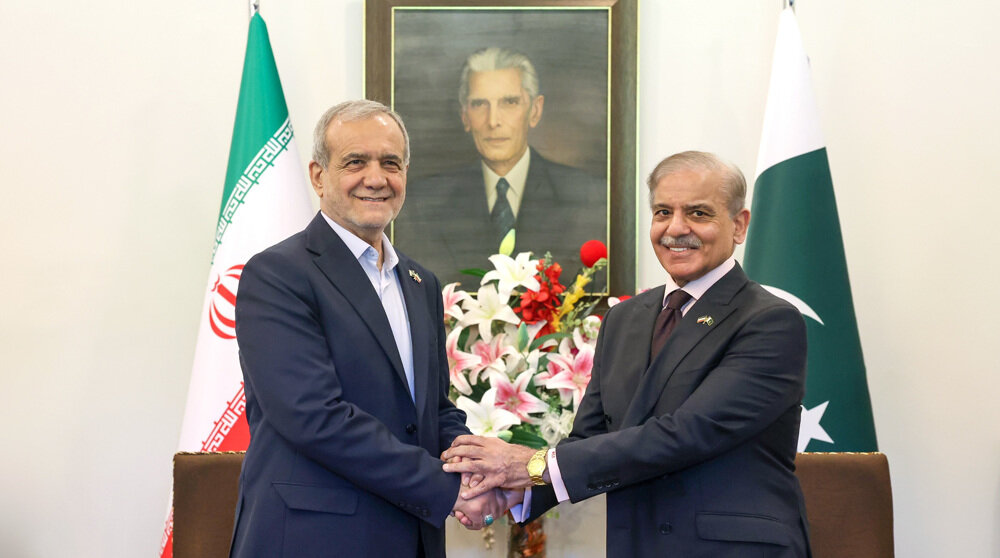Iran and Pakistan are bridging borders and defying pressure

ISLAMABAD – The visit of Iranian President Masoud Pezeshkian to Islamabad over the weekend was much more than a routine diplomatic engagement.
It sent a timely message to the region and the world. He arrived following Iran’s open confrontation with Israel, and just as two top Pakistani officials—Deputy Prime Minister Ishaq Dar and Chief of Army Staff General Asim Munir—had visited Washington and held discreet meetings with policymakers across the political spectrum. In this geopolitical context, Pakistan’s warm embrace of Iran signals a rebalancing of diplomacy that deserves attention.
The significance of President Pezeshkian’s visit is further elevated by the fact that this was his first official trip abroad. It was a gesture reflecting trust, closeness, and a shared sense of priorities in diplomatic protocol. Nowhere could this symbolism have been more pronounced than in Lahore, where he visited the shrine of Muhammad Iqbal—a nod to civilizational kinship and intellectual affinity. The verse by Iqbal— “If Tehran becomes the Geneva of the East, perhaps the destiny of the world may change”—resonates as more than poetry. It reads like a mission statement.
Bilateral discussions focused on trade, security, energy cooperation, and regional convergence. Both nations pledged to raise annual bilateral trade to USD 10 billion, up from the current USD 3 billion—a commitment that, if realized, could revive economic tourism and unlock potential long stifled by sanctions, border tensions, and bureaucratic red tape. Notably, the talks also addressed the establishment of Free Economic and Trade Zones, border markets, and transit corridors that could link Iran not only to Pakistan but also to China, Central Asia, and Europe via the Silk Road.
Before his departure from Tehran, President Pezeshkian said, “We shall have a Silk Route and connect with Pakistan and China, and this road may extend to Europe.” This aspiration aligns neatly with Islamabad’s ambition to position itself as a trading hub within the China-Pakistan Economic Corridor (CPEC). Geography is to diplomacy what blood is to the veins. Iran’s westward reach and Pakistan’s eastward orientation can complement each other—provided vision is translated into execution.
Energy cooperation, long viewed as an underutilized area, is once again gaining traction. Foreign Minister Ishaq Dar told reporters that “America cannot afford to ignore Pakistan’s national interest, and for Pakistan, American sanctions are of no significance.” The long-delayed Iran-Pakistan gas pipeline—stalled for years due to geopolitical constraints—is being revisited with renewed determination. Iran has already completed its segment; facing energy shortages and rising fuel prices, Islamabad now appears more willing to challenge longstanding taboos.
Energy provided by a friendly nation like Iran is more than just an economic supplement—it adds strategic depth to Pakistan’s economy.
Remarkably, 12 Memoranda of Understanding (MoUs) and agreements were signed during the visit, covering areas including science, ICT, tourism, plant protection, cultural exchange, maritime safety, judicial cooperation, and meteorological collaboration. These agreements suggest a pivot toward practical cooperation over symbolic gestures—though implementation remains the real test.
Prime Minister Shehbaz Sharif reiterated Pakistan’s support for Iran’s right to peaceful nuclear energy. During a joint press conference, he stated that “Iran has the right to develop nuclear capabilities for peaceful purposes.”
This firm stance on international law echoes Iran’s own position. At a time when the world is marked by tension and American pressure is mounting, Pakistan’s position upholding national sovereignty over alignment with external expectations is significant.
However, bilateralism was not the sole objective of the visit. It must be viewed in the broader context of a shifting, multipolar world. When Israeli airstrikes shook Iran in June, Pakistan issued strong condemnations. The Parliament even passed a rare, cross-party resolution expressing solidarity with Iran and opposing Israeli aggression. This act sent a clear signal that Islamabad will not remain a passive observer when regional neighbors face destabilization.
This spirit of multilateral diplomacy was echoed in the recent Shanghai Cooperation Organization (SCO) joint declaration. As both China and Russia express concern over Israeli overreach, a freer geopolitical space is emerging. Their endorsement of Iranian sovereignty is a welcome development. At this juncture, Pakistan appears eager to pursue a multi-aligned foreign policy—one not constrained by traditional alliances.
Even minor reconciliatory gestures were made during President Pezeshkian’s visit. In his presence, Prime Minister Shehbaz Sharif stated that Pakistan is open to dialogue with India—implying that Islamabad prefers engagement over confrontation, even with adversaries. Such sentiments would not be out of place in global capitals.
There are still severe obstacles to overcome, however. There is still more paper than reality in the Iran-Pakistan gas pipeline. Previously, the efforts to bolster the trade ended in smoke of red tapes and influence of the third parties. There are still tensions across the border including cross border militancy in Balochistan. Intelligence sharing and coordinated counter-terror measures are now recognized on each of these countries as having reached an agreement on the same. Whether this recent devoutness will be sustained through stress is but a question upon which time is to judge.
The bets are big And in case the renewed interaction between Tehran and Islamabad is supported by institutional continuity, infrastructural commitment and geopolitical realism, it can become the building block of a larger regional rearrangement one which will take pride in sovereignty, stability, and economic development. The Middle East and South Asia have long enough been postponing the growth because of external interference and internal divisions.
It may now be time to reimagine regional diplomacy in terms of shared heritage, mutual strategic interests, and reciprocal respect. Iqbal’s dream of Tehran as the “Geneva of the East” was not fantasy, but a blueprint for a viable geopolitical alternative—one yet to be realized.
It cannot be overstressed that Pakistan and Iran should stay the course beyond ceremonial visits and beyond strategic ambiguity and might yet open the door to a region governed by cooperation rather than conflict. And that, at this particular time of trouble, is no bad thing to carry.
Leave a Comment